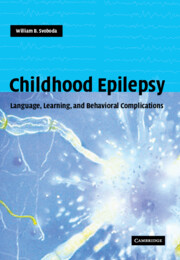Book contents
- Frontmatter
- Contents
- Preface
- Glossary
- 1 Looking ahead
- Part I Speech and language problems
- Part II Learning problems
- Part III Behavior problems
- 27 Mental health needs
- 28 Psychologic development
- 29 Seizure types and modifying factors
- 30 Overview: extrinsic factors
- 31 Behavior problems: general
- 32 Attention deficit disorders
- 33 Anxiety disorders
- 34 Mood disorders
- 35 Disruptive behavior problems
- 36 Psychoses of epilepsy
- 37 Non-epileptic events
- 38 Possible treatment issues
- 39 Helping with psychiatric problems
- 40 Epilog
- Index
- References
30 - Overview: extrinsic factors
from Part III - Behavior problems
Published online by Cambridge University Press: 26 October 2009
- Frontmatter
- Contents
- Preface
- Glossary
- 1 Looking ahead
- Part I Speech and language problems
- Part II Learning problems
- Part III Behavior problems
- 27 Mental health needs
- 28 Psychologic development
- 29 Seizure types and modifying factors
- 30 Overview: extrinsic factors
- 31 Behavior problems: general
- 32 Attention deficit disorders
- 33 Anxiety disorders
- 34 Mood disorders
- 35 Disruptive behavior problems
- 36 Psychoses of epilepsy
- 37 Non-epileptic events
- 38 Possible treatment issues
- 39 Helping with psychiatric problems
- 40 Epilog
- Index
- References
Summary
Many children with epilepsy have no behavioral problems, perform satisfactorily in school, and are socially well adjusted (Holmes, 1987). Some do have problems, however, and need help lest the social and behavioral problems become more handicapping than the seizures.
Emotional disturbances may be reactions to coping with both intrinsic and extrinsic causes, including the reactions of the family and others (Guerrant et al., 1962). Medications may alter behavior and cognition, leading to feelings of lack of control and inadequate social and academic functioning (Weisbrot & Ettinger, 1998). Problems of interacting with others may be influenced by a low intelligence, language difficulties, specific learning disabilities, physical handicaps, family problems, school difficulties, and later vocational problems (Henricksen, 1977). The severity of the epilepsy rather than the condition itself appears to be the main determinant of psychosocial and social consequences (Avondet et al., 1991). The basic approaches to such extrinsic disturbances include a combination of individual and family therapy, and medications to treat anxiety, depression, shame, embarrassment, and resentment.
The child
Epilepsy exists simultaneously as an individual medical disorder and as a family problem. The child must adapt to the epilepsy while developing a sense of self (Ziegler, 1981). Psychosocial problems in children with epilepsy may reflect the way they were brought up by their parents (Henricksen, 1977). A child has to find ways of adapting to the epilepsy while developing strategies for dealing with the family reactions.
- Type
- Chapter
- Information
- Childhood EpilepsyLanguage, Learning and Behavioural Complications, pp. 443 - 458Publisher: Cambridge University PressPrint publication year: 2004



